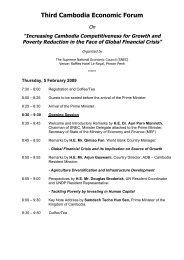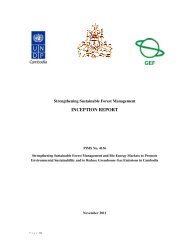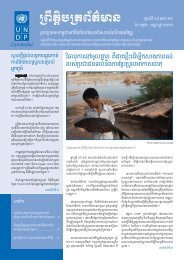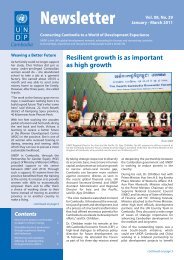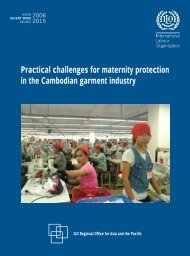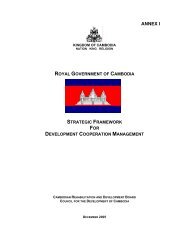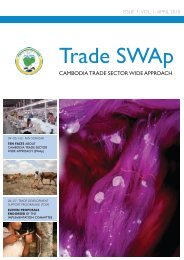UN Analysis Final.pdf - United Nations in Cambodia
UN Analysis Final.pdf - United Nations in Cambodia
UN Analysis Final.pdf - United Nations in Cambodia
Create successful ePaper yourself
Turn your PDF publications into a flip-book with our unique Google optimized e-Paper software.
V<br />
YOUTH AND<br />
EMPLOYMENT<br />
NO MATTER HOW HARD WE WORK, OUR SALARY FROM THE GARMENT FACTORY IS BARELY<br />
ENOUGH AT PRESENT FOR OUR MONTHLY EXPENSES…WE ARE IN DEBT ALMOST EVERY<br />
MONTH BUT THIS JOB SUITS US SINCE WE KNOW NOTHING… – FGD WITH FEMALE YOUTH<br />
WORKING IN GARMENT FACTORIES, PHNOM PENH<br />
<strong>Cambodia</strong> has experienced strong economic growth, averag<strong>in</strong>g 8.2 per cent per annum between<br />
1997 and 2007 (CDRI 2008). This growth has brought about changes to the structure of the economy.<br />
However, much of the growth has been concentrated <strong>in</strong> a few sectors: garment manufactur<strong>in</strong>g,<br />
construction, transport and tourism and restaurants. The agriculture sector still absorbs more than 60 per cent<br />
of the labour force despite its comparably slower growth rate at 3.4 per cent between 1994 and 2004. Overall,<br />
most of the <strong>in</strong>creased demand has been <strong>in</strong> the urban areas, accelerat<strong>in</strong>g the rural-urban divide. Recently,<br />
employment is estimated to have grown at a rate of 3.3 per annum from 1997 to 2007. Currently 300,000<br />
young people are enter<strong>in</strong>g the labour market annually – a number that is expected to rise to 400,000 over<br />
the years ahead (<strong>UN</strong>DP and ILO 2007). Without susta<strong>in</strong>able growth unemployment will become an <strong>in</strong>creas<strong>in</strong>g<br />
problem.<br />
Without a coord<strong>in</strong>ated response, <strong>Cambodia</strong> will likely suffer not only huge youth unemployment, but a<br />
paucity of decent work opportunities and high levels of economic and social uncerta<strong>in</strong>ty. Recently, the<br />
Government and other stakeholders have worked to address the problem of youth unemployment both<br />
through policies, such as employment legislation for youth, and enhanc<strong>in</strong>g social protection. The youth<br />
employment challenge is enormous. With economic and political stability br<strong>in</strong>g<strong>in</strong>g <strong>in</strong> more <strong>in</strong>vestment for<br />
rural and agricultural development, as noted previously, education will be key to the open<strong>in</strong>g door to decent<br />
employment.<br />
5.1 A REVIEW OF YOUTH-RELATED EMPLOYMENT POLICIES<br />
The Government has implemented many regulatory mechanisms and social safety nets <strong>in</strong> support of an<br />
active youth labour force. The National Strategic Development Plan (2006−2010) sets out measures to<br />
implement the Rectangular Strategy and to meet the <strong>Cambodia</strong>n Millennium Development Goal targets<br />
for 2010. Towards this aim, MoLVT strategically focuses on four ma<strong>in</strong> areas: (1) job creation; (2) improved<br />
work<strong>in</strong>g conditions; (3) implementation of social safety nets <strong>in</strong> conjunction with the labour law; and (4)<br />
human resource development (MoLVT 2008a).<br />
Situation <strong>Analysis</strong> of Youth <strong>in</strong> <strong>Cambodia</strong><br />
53




